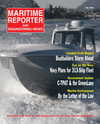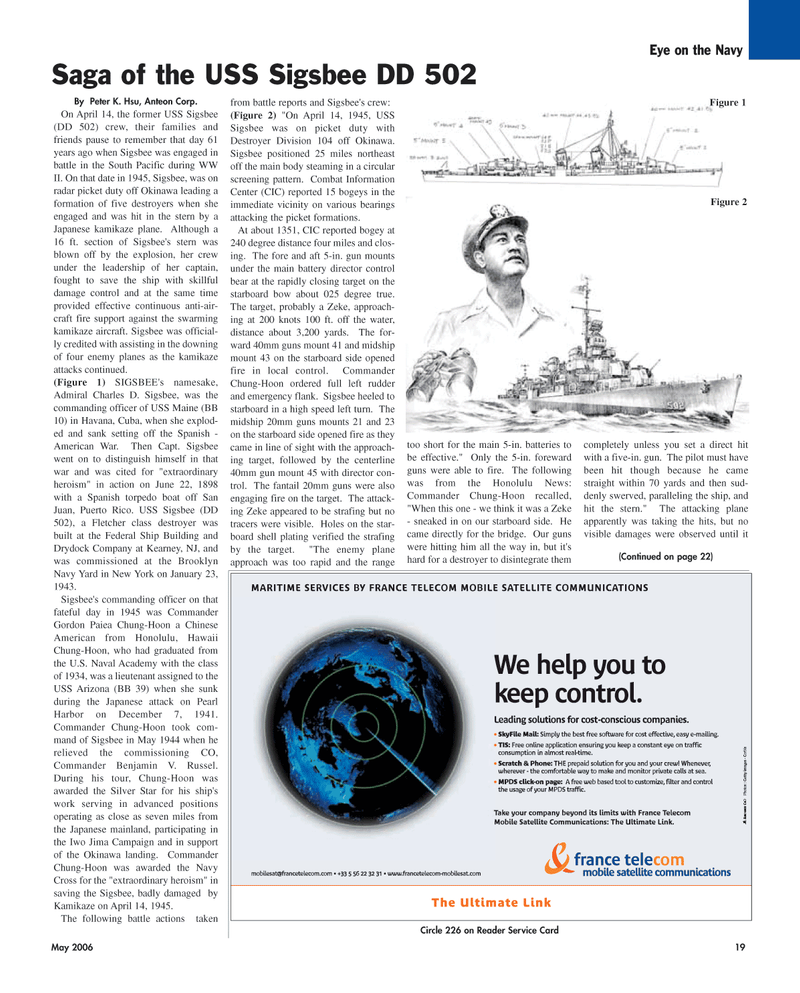
Page 19: of Maritime Reporter Magazine (May 2006)
The Marine Enviroment
Read this page in Pdf, Flash or Html5 edition of May 2006 Maritime Reporter Magazine
May 2006 19
By Peter K. Hsu, Anteon Corp.
On April 14, the former USS Sigsbee (DD 502) crew, their families and friends pause to remember that day 61 years ago when Sigsbee was engaged in battle in the South Pacific during WW
II. On that date in 1945, Sigsbee, was on radar picket duty off Okinawa leading a formation of five destroyers when she engaged and was hit in the stern by a
Japanese kamikaze plane. Although a 16 ft. section of Sigsbee's stern was blown off by the explosion, her crew under the leadership of her captain, fought to save the ship with skillful damage control and at the same time provided effective continuous anti-air- craft fire support against the swarming kamikaze aircraft. Sigsbee was official- ly credited with assisting in the downing of four enemy planes as the kamikaze attacks continued. (Figure 1) SIGSBEE's namesake,
Admiral Charles D. Sigsbee, was the commanding officer of USS Maine (BB 10) in Havana, Cuba, when she explod- ed and sank setting off the Spanish -
American War. Then Capt. Sigsbee went on to distinguish himself in that war and was cited for "extraordinary heroism" in action on June 22, 1898 with a Spanish torpedo boat off San
Juan, Puerto Rico. USS Sigsbee (DD 502), a Fletcher class destroyer was built at the Federal Ship Building and
Drydock Company at Kearney, NJ, and was commissioned at the Brooklyn
Navy Yard in New York on January 23, 1943.
Sigsbee's commanding officer on that fateful day in 1945 was Commander
Gordon Paiea Chung-Hoon a Chinese
American from Honolulu, Hawaii
Chung-Hoon, who had graduated from the U.S. Naval Academy with the class of 1934, was a lieutenant assigned to the
USS Arizona (BB 39) when she sunk during the Japanese attack on Pearl
Harbor on December 7, 1941.
Commander Chung-Hoon took com- mand of Sigsbee in May 1944 when he relieved the commissioning CO,
Commander Benjamin V. Russel.
During his tour, Chung-Hoon was awarded the Silver Star for his ship's work serving in advanced positions operating as close as seven miles from the Japanese mainland, participating in the Iwo Jima Campaign and in support of the Okinawa landing. Commander
Chung-Hoon was awarded the Navy
Cross for the "extraordinary heroism" in saving the Sigsbee, badly damaged by
Kamikaze on April 14, 1945.
The following battle actions taken from battle reports and Sigsbee's crew: (Figure 2) "On April 14, 1945, USS
Sigsbee was on picket duty with
Destroyer Division 104 off Okinawa.
Sigsbee positioned 25 miles northeast off the main body steaming in a circular screening pattern. Combat Information
Center (CIC) reported 15 bogeys in the immediate vicinity on various bearings attacking the picket formations.
At about 1351, CIC reported bogey at 240 degree distance four miles and clos- ing. The fore and aft 5-in. gun mounts under the main battery director control bear at the rapidly closing target on the starboard bow about 025 degree true.
The target, probably a Zeke, approach- ing at 200 knots 100 ft. off the water, distance about 3,200 yards. The for- ward 40mm guns mount 41 and midship mount 43 on the starboard side opened fire in local control. Commander
Chung-Hoon ordered full left rudder and emergency flank. Sigsbee heeled to starboard in a high speed left turn. The midship 20mm guns mounts 21 and 23 on the starboard side opened fire as they came in line of sight with the approach- ing target, followed by the centerline 40mm gun mount 45 with director con- trol. The fantail 20mm guns were also engaging fire on the target. The attack- ing Zeke appeared to be strafing but no tracers were visible. Holes on the star- board shell plating verified the strafing by the target. "The enemy plane approach was too rapid and the range too short for the main 5-in. batteries to be effective." Only the 5-in. foreward guns were able to fire. The following was from the Honolulu News:
Commander Chung-Hoon recalled, "When this one - we think it was a Zeke - sneaked in on our starboard side. He came directly for the bridge. Our guns were hitting him all the way in, but it's hard for a destroyer to disintegrate them completely unless you set a direct hit with a five-in. gun. The pilot must have been hit though because he came straight within 70 yards and then sud- denly swerved, paralleling the ship, and hit the stern." The attacking plane apparently was taking the hits, but no visible damages were observed until it
Circle 226 on Reader Service Card
Eye on the Navy
Saga of the USS Sigsbee DD 502
Figure 2
Figure 1 (Continued on page 22)
MR MAY2006 #3 (17-24).qxd 5/8/2006 11:22 AM Page 19

 18
18

 20
20
